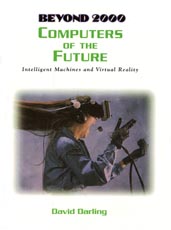Glossary
animat
A robot that looks and behaves like a simple kind of animal.
artificial neural network
A type of computer that works in a similar way to a collection of brain cells.
artificial intelligence
The field of study aimed at developing computers that can think and learn in ways that we would consider intelligent.
byte
A unit of computer data, equivalent to a single character, such as a letter or a digit.
CD-ROM
A compact disk on which information is recorded as tiny pits and blanks on a mirror-like surface. ROM stands for "Read-Only Memory," which means that, once encoded, a CD-ROM cannot have any other information stored on it.
chip
A small crystal, usually of silicon, on the surface of which have been formed many thousands, or even millions, of electronic components, such as transistors.
cyberspace
The popular name for the imaginary place in which all computer-generated information can be thought to exist.
data
Any items of information. In computer terms, data refers to the information given to a computer to be processed.
database
A complete collection of information on a particular topic, stored in a form that can be accessed by computer.
dataglove
A special glove that can sense the position and movements of a wearer's hand so that the person can interact with a virtual reality system.
datasuit
A special bodysuit equipped to detect the movements of a wearer's arms, legs, and body so that the person can fully interact with a virtual reality system.
disk drive
A storage device that provides access to various forms of storage media, such as a hard disk or a CD-ROM.
electronic
Having to do with the control of electric currents by devices such as transistors.
electronic mail (email)
Messages sent among people working at nearby or distant computers that are linked in a network.
hacker
A person who breaks into computer systems from a remote location with the intention of creating mischief or stealing or damaging confidential information.
hard disk
A stiff disk that is not normally removed from a computer system and that can hold large amounts of data and software.
hardware
The machinery of a computer, or any part of the computer that can be seen or touched.
high-definition television (HDTV)
A television system that has twice the standard number of scanning lines per frame and therefore produces pictures that have greater detail.
icon
A small picture or symbol that is displayed on a computer screen to give the user a clear choice of what to do next.
information superhighway
A popular name for the global high-speed data communication network that will eventually link electronic information systems all over the world.
infrared
A type of invisible radiation. Infrared rays lie just beyond the red end of the spectrum and can be felt as heat waves.
interactive
A type of program of computer that allows the user to control what happens from one moment to the next.
Internet
The worldwide "network of networks" that links millions of computers and computer users around the globe.
memory
The internal, high-speed storage section of a computer.
microchip technology
The techniques used to design and manufacture chips that contain components of microscopic size. <
microprocessor
A single chip that functions as the processing section of a computer.
modem
A device for changing computer data into a form that can be sent over a phone line.
mouse
A palm-sized device, with one or more buttons, that can be rolled on a flat surface and used to select items, such as icons, displayed on a screen.
multimedia
As applied to computers, the ability to work with different kinds of high-quality sounds, pictures, and text, produced with the help of a variety of equipment, including CD-ROMs.
network
A set of interconnected parts, such as computers, joined together by communication links.
neural network
The network of interconnected neurons in the brain.
optical computer
A computer that processes information by using beams of light instead of pulses of electricity.
optical fiber
A flexible, optically transparent fiber, usually made of glass or plastic, through which light can be transmitted by successive internal reflections.
parallel processing
Performing a number of calculations in different parts of a computer at the same time.
personal computer (PC)
A computer designed for use by an individual.
program
The step-by-step instructions that tell a computer how to carry out a certain task.
sensor
A device that detects conditions in the environment.
silicon
A substance, found in sand, from which almost all present-day chips are made.
simulation
A computer representation of a real or imaginary process.
software
Programs or commands that control or instruct computers.
supercomputer
At present, the largest and more powerful kind of computer.
transistor
An electronic device that, in a computer, works as a switch that can represent and help process information.
transphasor
A device that performs the same function as a transistor but that is switched using beams of light instead of pulses of electricity.
virtual reality (VR)
The illusion of a real environment created by a computer, with which illusion a person can interact.

